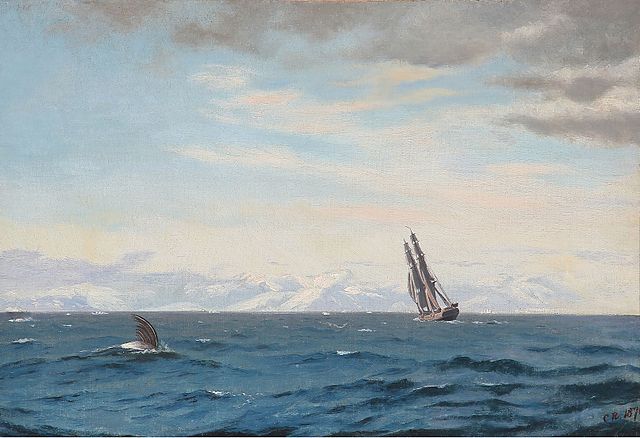Cancelation Culture, the Birth of the Semicolon, and Whales

Where did “cancelation” culture come from, and what, if anything, can be done about it? J. J. Gould reviews Robby Soave’s Panic Attack: “It’s not uncommon in skeptical accounts of ‘political correctness’ to encounter the idea that radical politics goes too far in an illiberal direction. But Soave’s account is different. The physics of contemporary radicalism that he describes isn’t really linear, in the sense that ‘too far’ would imply, so much as circular: as liberal-democratic mores become increasingly meaningless among radicals, they themselves increasingly see only left versus right, socialist versus fascist, radicalism versus radicalism. The only lucid way to respond to the world and win the future is, now, to understand that liberals are objectively allied with your most extreme political enemies; and the more forceful you imagine those enemies to be, the more force you’ll consider necessary and justified to counter them.”
Speaking of canceling (the ordinary kind), the Gawker relaunch has been nixed for now: “Bustle Digital Group, whose founder and CEO Bryan Goldberg (pictured above) bought the assets of Gawker in a bankruptcy auction last year, said it has canceled the planned September relaunch of the notoriously snarky property and laid off the staff that was hired to run it. ‘We are postponing the Gawker relaunch,’ Bustle Digital Group said in a statement. ‘For now, we are focusing company resources and efforts on our most recent acquisitions, Mic, The Outline, Nylon and Inverse.’”
Also, Woodstock 50 has been canceled—this time for good. “Less than a month from when it was supposed to kick off, Woodstock 50 is officially canceled once and for all. Michael Lang, a cofounder of the original three-day concert, pulled the plug after attempting to move the event to Maryland.”
In other news: Viv Groskop reviews Sara Wheeler’s Mud and Stars: Travels in Russia with Pushkin and Other Geniuses of the Golden Age. “This entertaining and insightful book performs two functions. It’s a whistle-stop guide to the best of Russian literature from 1800 to 1910. And it’s a beautiful piece of travel writing about the Russia of all our fantasies, from the ‘willow stooping over the central alley’ leading to Yasnaya Polyana, Tolstoy’s estate south of Moscow, to the distant shores of Lake Baikal, where Wheeler finds a delicious meal of white fish in a place where Chekhov could find only vodka.”
The birth of the semicolon: “The semicolon was born in Venice in 1494. It was meant to signify a pause of a length somewhere between that of the comma and that of the colon, and this heritage was reflected in its form, which combines half of each of those marks.”
Edward Snowden memoir to be published in September: “Out on 17 September, the book will be published in more than 20 countries and will detail how and why the former CIA agent and NSA contractor decided to reveal the US government’s plans for mass surveillance around the world and in the US – which included monitoring phone calls, text messages and emails.”
Essay of the Day:
Yesterday, I noted the correspondence between Saul Bellow and Bette Howland. Let’s follow that up with Abigail Deutsch’s essay in Harper’s on Howland’s “semi-autobiographical” fiction:
“Howland was an attentive student of social rules; much of her work lies in a borderland between sociology and poetry. Her stories brim with marvelously peculiar people—many of whom, in one way or another, resemble Howland herself. In loving, lacerating sketches, she conveys Chicago’s libraries, courthouses, movie theaters, and old-age homes. All the while, she depicts the colorful citizens, often poor, who spend time in such establishments, pointedly fixing her gaze on those whom society overlooks. (She applies similar attention to her tales of family life, which explore exclusion and discomfort in a narrower context, and which sometimes overlap with her city chronicles.) ‘Let us speak frankly,’ she writes in ‘Public Facilities.’ ‘Where are people to go? People, I mean, who have no place to go.’ And what do those people do there?
“For that matter, where—in the decades between her literary success and the appearance, in May, of a selection of her work—had Bette Howland gone? Four years after publishing W-3, her first book, she put out her second, Blue in Chicago (1978), and won a Guggenheim fellowship. A MacArthur followed Things to Come and Go (1983), her third and final volume. Saul Bellow was a friend, mentor, and occasional lover; for decades, he supported her and her work. ‘I’ve rarely had such affectionate appreciation for anyone,’ he wrote in a 1967 letter. ‘A surprising statement, now that I’ve written it. But then I seem to have dismissed certain forms of self-regard.’ Reviewers showered appreciation on Howland, too, praising her humor, her voice, and above all her keen capacity for observation.
“On one point they didn’t agree, however: What genre was Howland writing in? One critic called Blue in Chicago—a suite of narratives that explore the idiosyncrasies of city and family life—‘a collection of dense, eloquent, meditative, largely autobiographical essays.’ Another considered them ‘semi-autobiographical stories,’ and yet another, ‘short, interlocking fictional pieces.’ For Howland, the question was immaterial. ‘When people worry about whether something is fiction or nonfiction, they are worrying about how much invention there is,’ she told the magazine StoryQuarterly. ‘They should be worrying about how much imagination there is. . . . There is very little invention in Blue. There is a lot of imagination.’”
Photos: Whales
Receive Prufrock in your inbox every weekday morning. Subscribe here.